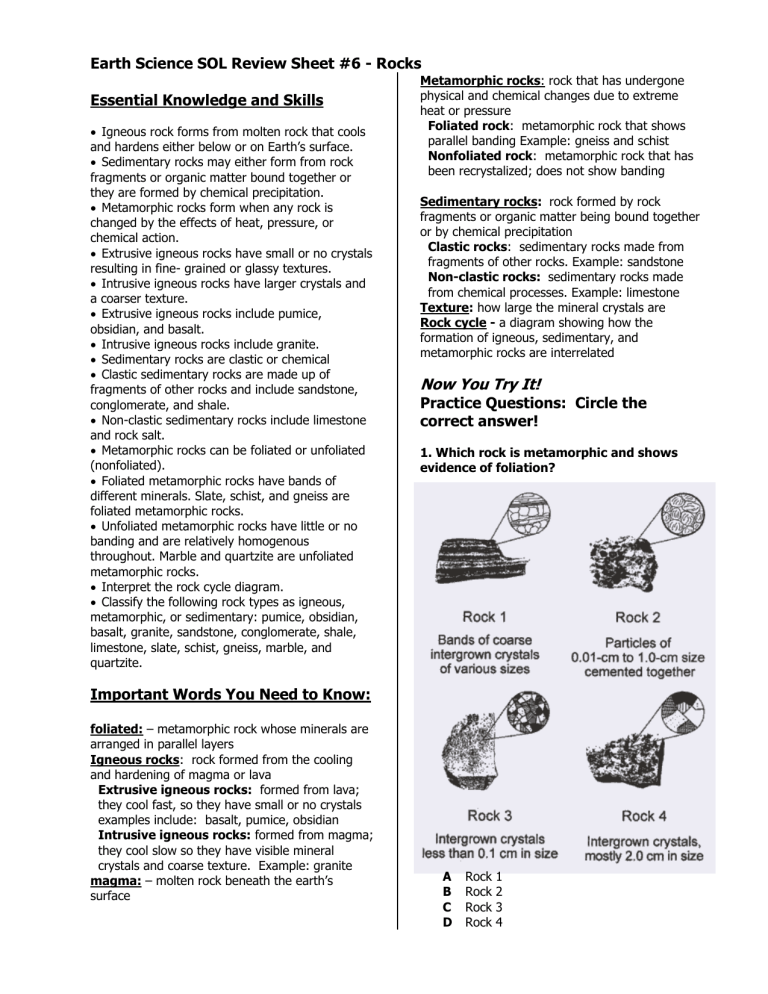Earth Science SOL Review Sheet: Rocks

Earth Science SOL Review Sheet #6 - Rocks
Essential Knowledge and Skills
Igneous rock forms from molten rock that cools and hardens either below or on Earth’s surface.
Sedimentary rocks may either form from rock fragments or organic matter bound together or they are formed by chemical precipitation.
Metamorphic rocks form when any rock is changed by the effects of heat, pressure, or chemical action.
Extrusive igneous rocks have small or no crystals resulting in fine- grained or glassy textures.
Intrusive igneous rocks have larger crystals and a coarser texture.
Extrusive igneous rocks include pumice, obsidian, and basalt.
Intrusive igneous rocks include granite.
Sedimentary rocks are clastic or chemical
Clastic sedimentary rocks are made up of fragments of other rocks and include sandstone, conglomerate, and shale.
Non-clastic sedimentary rocks include limestone and rock salt.
Metamorphic rocks can be foliated or unfoliated
(nonfoliated).
Foliated metamorphic rocks have bands of different minerals. Slate, schist, and gneiss are foliated metamorphic rocks.
Unfoliated metamorphic rocks have little or no banding and are relatively homogenous throughout. Marble and quartzite are unfoliated metamorphic rocks.
Interpret the rock cycle diagram.
Classify the following rock types as igneous, metamorphic, or sedimentary: pumice, obsidian, basalt, granite, sandstone, conglomerate, shale, limestone, slate, schist, gneiss, marble, and quartzite.
Metamorphic rocks: rock that has undergone physical and chemical changes due to extreme heat or pressure
Foliated rock: metamorphic rock that shows
parallel banding Example: gneiss and schist
Nonfoliated rock: metamorphic rock that has
been recrystalized; does not show banding
Sedimentary rocks: rock formed by rock fragments or organic matter being bound together or by chemical precipitation
Clastic rocks: sedimentary rocks made from
fragments of other rocks. Example: sandstone
Non-clastic rocks: sedimentary rocks made
from chemical processes. Example: limestone
Texture: how large the mineral crystals are
Rock cycle - a diagram showing how the formation of igneous, sedimentary, and metamorphic rocks are interrelated
Important Words You Need to Know:
foliated: – metamorphic rock whose minerals are arranged in parallel layers
Igneous rocks: rock formed from the cooling and hardening of magma or lava
Extrusive igneous rocks: formed from lava;
they cool fast, so they have small or no crystals
examples include: basalt, pumice, obsidian
Intrusive igneous rocks: formed from magma;
Now You Try It!
Practice Questions: Circle the correct answer!
1. Which rock is metamorphic and shows evidence of foliation?
they cool slow so they have visible mineral
crystals and coarse texture. Example: granite
magma: – molten rock beneath the earth’s surface
A Rock 1
B Rock 2
C Rock 3
D Rock 4
2. The diagrams below show the crystals of four different rocks viewed through the same hand lens. Which crystals most likely formed from molten material that cooled and solidified most rapidly?
A B
C D
3. Which of the following rocks is NOT igneous?
A Granite
B Gneiss
C Obsidian
D Basalt
4. The "weathering" position in the rock
cycle would be found–
A At position 1
B At position 2
C At position 3
D At position 4
5. During metamorphism, shale becomes–
A Marble
B Quartzite
C Slate
D Gneiss
6.
This picture shows a section of the Rocky
Mts.. The rocks are mainly limestone. The dark horizontal stripe is a sill. Barely noticeable, above and below the sill is a white band of metamorphic rock. What kind of rock should it be?
A Marble
B Quartzite
C Slate
D Basalt
7. The two types of metamorphic rock are–
A Foliated & nonfoliated
B Clastic & nonclastic
C Intrusive & extrusive
D Clastic & recrystalized
8. Which of these best describes intrusive
igneous rock?
A solidifies from lava, cools quickly, large crystals
B solidifies from lava, cools slowly, small crystals
C solidifies from magma, cools quickly, large crystals
D solidifies from magma, cools slowly, large crystals
9. Pumice is an igneous rock that can float on water. Which of these is most likely pumice?
A B
C D






